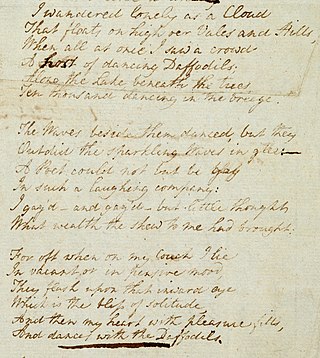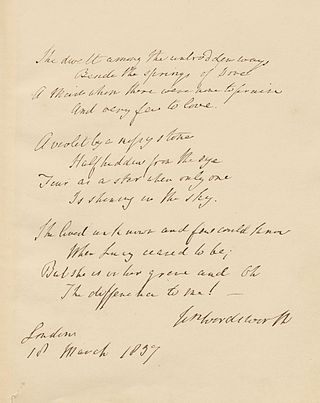Related Research Articles

William Wordsworth was an English Romantic poet who, with Samuel Taylor Coleridge, helped to launch the Romantic Age in English literature with their joint publication Lyrical Ballads (1798).

Dorothy Mae Ann Wordsworth was an English author, poet, and diarist. She was the sister of the Romantic poet William Wordsworth, and the two were close all their adult lives. Dorothy Wordsworth had no ambitions to be a public author, yet she left behind numerous letters, diary entries, topographical descriptions, poems, and other writings.

"I Wandered Lonely as a Cloud" is a lyric poem by William Wordsworth. It is one of his most popular, and was inspired by a forest encounter on 15 April 1802 that included himself, his younger sister Dorothy and a "long belt" of daffodils. Written in 1804, this 24 line lyric was first published in 1807 in Poems, in Two Volumes, and slightly revised in 1815.
"The Solitary Reaper" is a lyric poem by English Romantic poet William Wordsworth, and one of his best-known works. The poem was inspired by him and his sister Dorothy's stay at the village of Strathyre in the parish of Balquhidder in Scotland in September 1803.

"Ode: Intimations of Immortality from Recollections of Early Childhood" is a poem by William Wordsworth, completed in 1804 and published in Poems, in Two Volumes (1807). The poem was completed in two parts, with the first four stanzas written among a series of poems composed in 1802 about childhood. The first part of the poem was completed on 27 March 1802 and a copy was provided to Wordsworth's friend and fellow poet, Samuel Taylor Coleridge, who responded with his own poem, "Dejection: An Ode", in April. The fourth stanza of the ode ends with a question, and Wordsworth was finally able to answer it with seven additional stanzas completed in early 1804. It was first printed as "Ode" in 1807, and it was not until 1815 that it was edited and reworked to the version that is currently known, "Ode: Intimations of Immortality".

"Strange fits of passion have I known" is a seven-stanza poem ballad by the English Romantic poet William Wordsworth. Composed during a sojourn in Germany in 1798, the poem was first published in the second edition of Lyrical Ballads (1800). The poem describes the poet's trip to his beloved Lucy's cottage, and his thoughts on the way. Each of its seven stanzas is four lines long and has a rhyming scheme of ABAB. The poem is written in iambic tetrameter and iambic trimeter.

"She Dwelt Among the Untrodden Ways" is a three-stanza poem written by the English Romantic poet William Wordsworth in 1798 when he was 28 years old. The verse was first printed in Lyrical Ballads, 1800, a volume of Wordsworth's and Samuel Taylor Coleridge's poems that marked a climacteric in the English Romantic movement. The poem is the best known of Wordsworth's series of five works which comprise his "Lucy" series, and was a favorite amongst early readers. It was composed both as a meditation on his own feelings of loneliness and loss, and as an ode to the beauty and dignity of an idealized woman who lived unnoticed by all others except by the poet himself. The title line implies Lucy lived unknown and remote, both physically and intellectually. The poet's subject's isolated sensitivity expresses a characteristic aspect of Romantic expectations of the human, and especially of the poet's condition.

The Lucy poems are a series of five poems composed by the English Romantic poet William Wordsworth (1770–1850) between 1798 and 1801. All but one were first published during 1800 in the second edition of Lyrical Ballads, a collaboration between Wordsworth and Samuel Taylor Coleridge that was both Wordsworth's first major publication and a milestone in the early English Romantic movement. In the series, Wordsworth sought to write unaffected English verse infused with abstract ideals of beauty, nature, love, longing, and death.
William Wordsworth was an English Romantic poet who, with Samuel Taylor Coleridge, helped launch the Romantic Age in English literature with their 1798 joint publication, Lyrical Ballads. His early years were dominated by his experience of the countryside around the Lake District and the English moors. Dorothy Wordsworth, his sister, served as his early companion until their mother's death and their separation when he was sent to school.
The "Matthew" poems are a series of poems, composed by the English Romantic poet William Wordsworth, that describe the character Matthew in Wordsworth's poetry.
"We are Seven" is a poem written by William Wordsworth and published in his Lyrical Ballads. It describes a discussion between an adult poetic speaker and a "little cottage girl" about the number of brothers and sisters who dwell with her. The poem turns on the question of whether to account two dead siblings as part of the family.

"I travelled among unknown men" is a love poem completed in April 1801 by the English poet William Wordsworth and originally intended for the Lyrical Ballads anthology, but it was first published in Poems, in Two Volumes in 1807. The third poem of Wordsworth's "Lucy series", "I travelled..." was composed after the poet had spent time living in Germany in 1798. Due to acute homesickness, the lyrics promise that once returned to England, he will never live abroad again. The poet states he now loves England "more and more". Wordsworth realizes that he did not know how much he loved England until he lived abroad and uses this insight as an analogy to understand his unrequited feelings for his beloved, Lucy.
"Three years she grew in sun and shower" is a poem composed in 1798 by the English poet William Wordsworth, and first published in the Lyrical Ballads collection which was co-written with his friend and fellow poet Samuel Taylor Coleridge. As one of the five poems that make up the "Lucy series," the work describes the relationship between Lucy and nature using words and sentiments. The author creates an impression of the indifference of nature as the poem progresses. The care with which Nature had sculpted Lucy, and then casually let her "race" end, reflects Wordsworth's view of the harsh reality of life. Although Nature is indifferent, it also cares for Lucy enough to both sculpt and mould her into its own. Wordsworth valued connections to nature above all else. The poem thus contains both epithalamic and elegiac characteristics; the marriage described is between Lucy and nature, while her human lover is left to mourn in the knowledge that death has separated her from mankind, and she will forever now be with nature.
Lines Written at Shurton Bars was composed by Samuel Taylor Coleridge in 1795. The poem incorporates a reflection on Coleridge's engagement and his understanding of marriage. It also compares nature to an ideal understanding of reality and discusses isolation from others.
"A slumber did my spirit seal" is a poem that was written by William Wordsworth in 1798 and first published in volume II of the 1800 edition of Lyrical Ballads. It is part of a series of poems written about a mysterious woman named Lucy, whom scholars have not been able to identify and are not sure whether she was real or fictional. Although the name Lucy is not directly mentioned in the poem, scholars nevertheless believe it to be part of the "Lucy poems" due to the poem's placement in Lyrical Ballads.

Robert Anderson (1770–1833), was an English labouring class poet from Carlisle. He was best known for his ballad-style poems in Cumbrian dialect.

"Poor Susan" is a lyric poem by William Wordsworth composed at Alfoxden in 1797. It was first published in the collection Lyrical Ballads in 1798. It is written in anapestic tetrameter.

Peter Bell: A Tale in Verse is a long narrative poem by William Wordsworth, written in 1798, but not published until 1819.

The White Doe of Rylstone; or, The Fate of the Nortons is a long narrative poem by William Wordsworth, written initially in 1807–08, but not finally revised and published until 1815. It is set during the Rising of the North in 1569 and combines historical and legendary subject-matter. It has attracted praise from some critics, but has never been one of Wordsworth's more popular poems.
"Animal Tranquillity and Decay, A Sketch", also known as "Old Man travelling" is a poem written by William Wordsworth. It was published in 1798 in the first edition of Lyrical Ballads – a collection of poems created in collaboration with Samuel Taylor Coleridge. The poem is estimated to have been composed either in late 1796 or early 1797. "Old Man Travelling" used to be a part of another poem by William Wordsworth, called "The Old Cumberland Beggar", devised as a description of the eponymous beggar; however, "Old Man Travelling" was completed earlier and made into a separate piece. The poem has been referred to as "a short sequel" to "The Old Cumberland Beggar", and Wordsworth himself regarded it as "an overflowing" of it. The form of the poem has been described as "a sonnet-like poem in two acts". It consists of one stanza written in blank verse.
References
- 1 2 Moorman 1968 p. 426
- ↑ Wordsworth 1991 pp. 293–294
- 1 2 Jones 1995 p. 9
- ↑ Jones 1995 p. ix
- ↑ Jones 1995 p. 11
- ↑ Jones 1995 p. 77
- ↑ Stork 1914 p. 305
- ↑ Weaver 1960 p. 233
- ↑ Garrod 1927 84–85
- ↑ Beer 1978 p. 95
- ↑ Langbaum 1967 p. 270
- ↑ Robinson 1967 p. 48
- ↑ Beer 1978 pp. 95–96
- ↑ Wordsworth 1991 p. 294
- ↑ Havens 1941 p. 21
- ↑ Havens 1941 p. 246
- ↑ De Man 1987 p. 12
- ↑ Jones 1995 p. 194
- ↑ Jones 1995 p. 58
- ↑ Arnold 1879 p. xxii
- ↑ Miscellanies 1886 p. 131
- ↑ Bradley 1959 p. 143
- Arnold, Matthew. "Preface" in Poems of Wordsworth. London: Macmillan, 1879.
- Beer, John. Wordsworth and the Human Heart. New York: Columbia University Press, 1978.
- Bradley, A. C. Oxford Lectures on Poetry. London: Macmillan, 1959.
- De Man, Paul. "Time and History in Wordsworth". Diacritics, Vol. 17, No. 4, (Winter, 1987), pp. 4–17.
- Garrod, Heathcote William. Profession of Poetry and Other Lectures. Ayer Publishing, 1967. ISBN 0-8369-0469-9
- Havens, Raymond. The Mind of a Poet. Baltimore: Johns Hopkins Press, 1941.
- Jones, Mark. The 'Lucy Poems': A Case Study in Literary Knowledge. Toronto: The University of Toronto Press, 1995. ISBN 0-8020-0434-2.
- Langbaum, Robert. "The Evolution of Soul in Wordsworth's Poetry". PMLA, Vol. 82, No. 2 (May 1967), pp. 265–272.
- Moorman, Mary. William Wordsworth A Biography: The Early Years 1770–1803. London: Oxford University Press, 1968.
- Robinson, Henry Crabb. The Diary of Henry Crabb Robinson. Oxford: Oxford University Press, 1967.
- Stork, Charles Wharton. "The Influence of the Popular Ballad on Wordsworth and Coleridge". PMLA, Vol. 29, No. 3 (1914), pp. 299–326.
- Swinburne, Algernon Charles. Miscellanies. New York: Worthington, 1886. OCLC 7291800.
- Weaver, Bennett. "Wordsworth: Poet of the Unconquerable Mind". PMLA, Vol. 75, No. 3 (Jun. 1960), pp. 231–237.
- Wordsworth, William. Poems by William Wordsworth. New York: McClure Phillips, 1907.
- Wordsworth, William. Lyrical Ballads. Routledge, 1991. ISBN 0-415-06388-4
